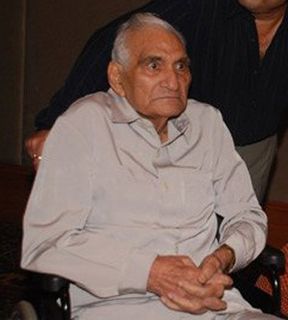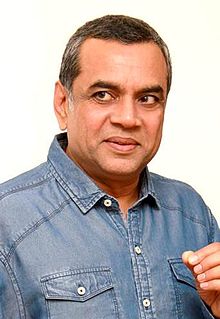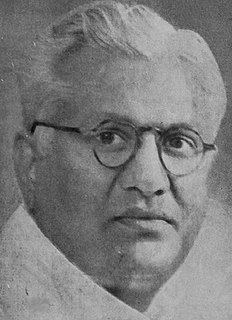Related Research Articles

Baldev Raj Chopra was an Indian director and producer of Bollywood movies and television serials. Best known for directing Hindi films like Naya Daur (1957), Sadhna (1958), Kanoon (1961), Gumrah (1963), Humraaz (1967), Insaaf Ka Tarazu (1980), Nikaah (1982), Awam (1987), and the producer of TV series, Mahabharat in 1988, he was awarded the Dadasaheb Phalke Award in 1998.

Paresh Rawal is an Indian film actor, comedian and politician known for his works notably in Bollywood. He was a member of parliament in the Lok Sabha of the Indian Parliament representing the Ahmedabad East constituency from 2014 to 2019. He is politically affiliated with the Bharatiya Janata Party. Rawal speaks Hindi, Gujarati, Marathi, Telugu and English. In 1994, he won the National Film Award for Best Supporting Actor for his performances in the films Woh Chokri and Sir. For the latter, he received his first Filmfare Award for Best Comedian. This was followed by Ketan Mehta's Sardar, which saw him playing the lead role of freedom fighter Vallabhbhai Patel, a role that got him national and international acclaim.

Khursheed Bano, often credited as Khursheed or Khurshid, was a singer and actress, and a pioneer of the Indian cinema. Her career ran through the 1930s and 1940s, before she migrated to Pakistan in 1948. Making her debut with Laila Majnu (1931), she acted in over thirty films in India. She is best known for her film Tansen (1943) with actor-singer K. L. Saigal, which featured many of her memorable songs.

Prakash Mehra was an Indian film director and producer known for his blockbuster Hindi films. He was one of the pioneers of masala films, along with Nasir Hussain, and Manmohan Desai. His collaborations with the actor Amitabh Bachchan resulted in several box office blockbusters and classics, due to which Mehra was considered among the 'Golden Directors' of his time.

The cinema of Pakistan or Lollywood, refers to the filmmaking industry in Pakistan. Pakistan is home to several film studios centres, primarily located in its two largest cities - Karachi and Lahore. Pakistani cinema has played an important part in Pakistani culture and in recent years has begun flourishing again after years of decline, delivering entertainment to audiences in Pakistan and expatriates abroad. Several film industries are based in Pakistan, which tend to be regional and niche in nature. Over 10,000 Urdu feature films have been produced in Pakistan since 1948, as well as over 8000 Punjabi, 6000 Pashto and 2000 Sindhi feature-length films. The first film ever produced was Husn Ka Daku in 1930, directed by Abdur Rashid Kardar in Lahore. The first Pakistani-film produced was Teri Yaad, directed by Daud Chand in 1948. Between 1947 and 2007, Pakistani cinema was based in Lahore, home to the nation's largest film industry. Pakistani films during this period attracted large audiences and had a strong cult following, was part of the cultural mainstream, widely available and imitated by the masses. During the early 1970s, Pakistan was the world's fourth largest producer of feature films. However, between 1977 and 2007, the film industry of Pakistan went into decline due to Islamization, strengthening of censorship laws and an overall lack of quality. Throughout the 1980s and 1990s, the film industry went through several periods of ups and downs, a reflection of its dependency on state funding and incentives. By 2000, the film industry in Lahore had collapsed and saw a gradual shift of Pakistani actors, actresses, producers and filmmakers from Lahore to Karachi. By 2007, the wounds of Pakistan's collapsed film industry began to heal and Karachi had cemented itself as the center of Pakistani cinema. This was the time new generation producers stepped into the industry with short films with quality story line and new technology led to an explosion of alternative form of Pakistani cinema. The shift has been seen by many as the leading cause for the "resurgence of Pakistani cinema". Despite the industry crisis starting in the mid-1980s, Pakistani films have retained much of their distinctive identity. Since the shift to Karachi, Pakistani films have once again began attracting a strong cult following.
Gul Hamid or Gul Hamid Khan (1905-1936) was an Indian film actor. He started his acting career in silent films and later played leading roles in talkies. He had many honors to his credit. He acted in Heer Ranjha, the first film produced in Punjabi and in Seeta, a talkie that won an honorary diploma in the 1934 Venice Film Festival and that was also the first Indian film shown at an International film festival. Hamid also wrote the script, acted in, and directed the film Khyber Pass (1936). Hamid died of Hodgkin's Disease in 1936.

Punjabi cinema, sometimes metonymously referred to as Pollywood, is the Punjabi language film industry centred around the state of Punjab in India. Mainly based in Amritsar.

Abdur Rashid Kardar (1904–1989), was an Indian actor, director and producer. He is credited as establishing the film industry in the Bhati Gate locality of Lahore, British India.
Abida Riaz, better known as Neelo, is a film actress from Lahore, Pakistan and mother of the renowned film actor Shaan Shahid.
Pheri Bhetaula is a 1989 Nepali romantic film. The cast includes the famous Bollywood star Manisha Koirala and Prakash Adhikari.
Nazir Ahmad Khan was a Pakistani film actor, director and producer. He was the first successful film hero in pre-independent India and later in Pakistan. Nazir was associated with almost two hundred films during his career, which spanned over a period of 55 years. Nazir Ahmed was widely known as Bao Jee in the film industries both in India and Pakistan.
Allauddin Butt, better known as simply Allauddin (Urdu: علاءُ الدین), was a Pakistani actor who worked in Pakistani Lollywood movies. His film career spanned over 4 decades.

Chandulal Jesangbhai Shah was a famous director, producer and screenwriter of Indian films, who founded Ranjit Studios in 1929.

Mehtab (1918–1997) was an Indian actress of Hindi/Urdu films who worked from 1928 to 1969. She was born in Sachin, Gujarat, to a Muslim family and named Najma. Her father, Nawab Sidi Ibrahim Mohammad Yakut Khan III, was the Nawab of Sachin, near Surat in the state of Gujarat. Starting her career in the late 1920s with small roles in films like Second Wife (1928), Indira B. A. (1929) and Jayant (1929), she went on to do character roles before acting in the lead opposite Ashraf Khan in Veer Kunal (1932). After almost a decade of doing mainly action-oriented roles, she came into prominence with the Kidar Sharma-directed Chitralekha (1941), due to her bathing scene in the film.
Husn Ka Daku is a 1929 action adventure silent film directed by A. R. Kardar. The film, also called Mysterious Eagle was made by Kardar's Playart Phototone. Kardar acted in this, his first production from Playart Phototone. Playart Phototone was a progression from United Player's Corporation, which he had set up in 1928. Husn Ka Daku was Kardar's debut directorial venture. It set the foundations for the Lahore film industry in the Bhati Gate area of Lahore. The director of photography was D. D. Dabke.
Sarfarosh also called Brave Hearts was a 1930 Indian silent film directed by A. R. Kardar. Made as action adventure film based on the RKO dramas, it was produced by Kardar's production company, "Playart Phototone". According to Hameeduddin Mahmood, the films had double titles up until the mid-1930s; the Hindi/Urdu name for the home market (India), and the English name for the overseas market. Kardar gave up acting after having starred in Husn Ka Daku (1929) and cast Gul Hamid in the main role. He also gave Rafiqe Ghaznavi a break as an actor in the film. Ghaznavi went on to become a famous music director.
Safdar Jung is a 1930 action costume silent film directed by A. R. Kardar. The film was the third to be produced by Kardar's United Players Pictures, following Husn Ka Daku (1929) and Sarfarosh (1930).
Farebi Shahzada also called The Shepherd, is a 1931 Indian cinema's action silent film directed by A. R. Kardar. The film was also known as Gudaria Sultan or The Shepherd King and was the fourth of seven films Kardar produced under Kardar's United Players Corporation, Lahore.
Khooni Katar also called Golden Dagger is a 1931 Indian cinema's action adventure silent film directed by A. R. Kardar. The film was also called Sunheri Khanjar and the fifth film to be produced by Kardar for his United Pictures Corporation. The film is famous for the debut of the actor-producer-director Nazir.
Farebi Daku also called Mysterious Bandit is a 1931 action silent film produced and directed by A. R. Kardar. Kardar set up his own production company "United Players Corporation" in 1928 and in quick succession produced and directed seven pictures, Husn Ka Daku (1929), Safdar Jung (1930), Sarfarosh (1930), Farebi Shahzada (1931), Khooni Katar (1931), Farebi Daku and The Wandering Dancer or Awara Raqasa. Awara Raqasa was the only film out of the seven produced by Kardar, which was directed by J. K. Nanda, who had received his direction and cinematography training in Germany.
References
- 1 2 3 4 5 "The Silent Era (1896–1931)". Cinema of Pakistan. Archived from the original on 16 October 2008. Retrieved 6 July 2008.
- ↑ "Our Founders". Film and TV Guide India. Archived from the original on 30 March 2015. Retrieved 6 July 2008.
- ↑ "Husn Ka Daku". Internet Movie Database . Retrieved 6 July 2008.